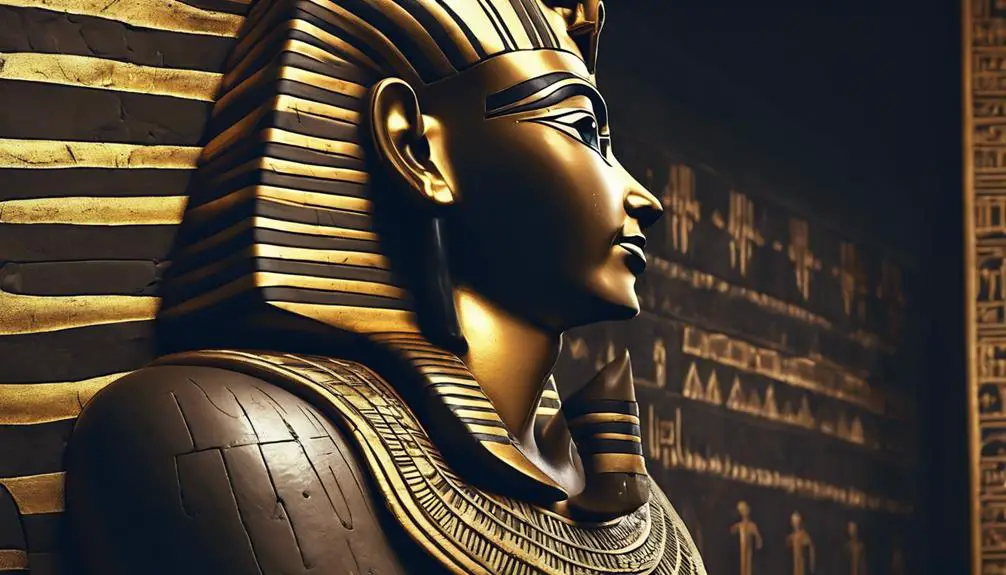Immerse yourself in tales of biblical villains, from deceitful serpents to tyrannical kings, and question the essence of evil itself.

Most Evil Person in the Bible
Just as Pandora's box unleashed chaos upon the world, the Bible introduces characters whose actions reverberate through history as embodiments of evil.
You've likely heard of the serpent's deception in Eden or King Herod's ruthless tyranny. Yet, deciding who stands as the most malevolent is a complex task.
Consider Judas Iscariot's betrayal, Jezebel's manipulations, or Pharaoh's hardened heart. Each story offers a unique perspective on morality, power, and betrayal.
As you contemplate these figures, ask yourself what criteria you use to measure evil and how these ancient narratives influence modern perceptions of right and wrong.
The answer might surprise you.
Key Takeaways
- Determining the "most evil" person in the Bible is subjective, influenced by their actions and the consequences thereof.
- Figures like Jezebel and King Herod stand out due to their manipulative actions and the moral bankruptcy they represent.
- The serpent's role in humanity's fall introduces the theme of temptation as a significant evil.
- Judas Iscariot's betrayal, motivated by disillusionment and greed, showcases personal betrayal as a profound form of evil.
The Serpent in Eden

In the biblical narrative of Genesis, the Serpent in Eden emerges as a pivotal antagonist, initiating humanity's fall from grace through cunning deception. You'll find that the Serpent's symbolism extends far beyond a mere antagonist role; it embodies the complex interplay of wisdom and malevolence, enlightenment and downfall. This duality offers a profound commentary on the nature of temptation and the inherent vulnerability of man.
Delving deeper, the Serpent's act of tempting Eve with the forbidden fruit isn't just a moment of deceit but a pivotal event that unravels Temptation's consequences on a cosmic scale. It's through this act that you witness the introduction of sin into the human condition, fundamentally altering humanity's relationship with divinity. This narrative posits the Serpent not merely as a disruptor but as the catalyst for a series of events that underscore the fragility of moral integrity when faced with the allure of forbidden knowledge.
Analyzing this episode, it's clear that the Serpent's role is integral to understanding the complex dynamics of temptation, sin, and their far-reaching consequences. The story serves as a cautionary tale, highlighting the perils of succumbing to temptation and the irreversible impact of such actions on human destiny.
King Herod's Tyranny
Transitioning from the allegorical deception of the Serpent in Eden, we now confront King Herod's tangible tyranny, a stark manifestation of power abused to the detriment of many. You witness a ruler whose paranoia and ambition led to the infamous Massacre of Innocents, an act that encapsulates his ruthless quest to maintain power at any cost. Historical records and biblical accounts paint a picture of a monarch willing to sacrifice the lives of countless infants in Bethlehem, purely to eliminate a perceived threat to his throne.
Analyzing Herod's reign further, one can't overlook his Architectural legacy, which on the surface appears as a testament to his greatness. His projects, including the expansion of the Second Temple in Jerusalem, serve as a paradox, juxtaposing his contributions to Judea's structural magnificence against the backdrop of his moral bankruptcy. This duality invites a deeper reflection on the nature of leadership and the ethical responsibilities it entails.
Herod's story, thus, serves as a cautionary tale of how the pursuit of power, when unchecked by moral constraints, can lead to atrocities that echo through history. His actions, driven by fear and despotism, offer a profound lesson on the consequences of tyranny.
Judas Iscariot's Betrayal

Judas Iscariot's act of betrayal, selling Jesus for thirty pieces of silver, starkly illustrates the devastating impact of personal greed and deception on the course of history. This event not only marked a pivotal moment in Christian narratives but also serves as a profound lesson on the destructive power of betrayal fueled by material gain. Analyzing Judas's motives reveals a complex interplay of disillusionment, perhaps a misguided attempt to force Jesus into a position of power, and undeniable greed. These motivations, however, don't excuse his actions but rather highlight the tragic path chosen by Judas.
Judas's remorse following his betrayal adds another layer to his character, suggesting a deep internal conflict between his actions and their consequences. The act of returning the thirty pieces of silver and his subsequent suicide are indicative of his overwhelming guilt and despair, yet they don't absolve him of the betrayal. This remorse, while significant, can't undo the chain of events his actions set into motion, underscoring the irreversible nature of certain decisions and their lasting impact on history.
Through Judas's story, one is compelled to reflect on the far-reaching implications of personal actions, especially when driven by greed and deception.
Jezebel's Manipulations
Reflecting on the profound implications of personal actions, especially those driven by greed and deception, brings us to the manipulative endeavors of Jezebel, another pivotal figure whose schemes had lasting effects on the biblical narrative. Her actions contributed significantly to Ahab's downfall, showcasing a profound example of how manipulative tactics can lead to the degradation of moral and ethical standards within leadership.
- Marriage to Ahab: Jezebel's marriage to King Ahab wasn't merely a political alliance but a strategic move to expand her influence. This union set the stage for her manipulative ventures, leading Ahab away from his faith.
- Promotion of Baal Worship: She aggressively promoted the worship of Baal, directly challenging the monotheistic foundation of Israelite religion. This not only caused a spiritual crisis but also a prophetic conflict, pitting her against the prophets of Yahweh.
- Naboth's Vineyard Incident: Perhaps her most infamous act was orchestrating the false accusation and execution of Naboth to seize his vineyard for Ahab, epitomizing her disregard for justice and human life.
- Conflict with Elijah: Jezebel's vendetta against Elijah, the prophet, underscored her determination to eliminate Yahweh's prophets, further fueling the prophetic conflict and demonstrating her ruthless attempt to consolidate power.
Jezebel's manipulations, driven by ambition and the desire for control, offer a cautionary tale about the dangers of unchecked power and the consequences of forsaking ethical principles for personal gain.
Pharaoh's Hardened Heart

In analyzing the narrative of Pharaoh in the Exodus story, we observe a striking example of divine sovereignty clashing with human will, particularly through the hardening of Pharaoh's heart. This depiction ignites the free will debate and showcases a profound instance of divine intervention within biblical lore.
Phase |
Emotion Evoked |
Impact |
|---|---|---|
Initial Refusal |
Frustration |
Sets the stage for conflict |
Plagues Begin |
Fear |
Demonstrates power imbalance |
Heart Hardens |
Defiance |
Escalates tension |
Continued Plagues |
Despair |
Highlights suffering |
Final Outcome |
Tragedy |
Culminates in loss |
This table encapsulates the emotional journey instigated by the hardening of Pharaoh's heart, effectively conveying the escalating conflict and its dire consequences. The hardening, whether interpreted as Pharaoh's own stubbornness or as divine intervention, serves as a pivotal element in the unfolding of the Exodus narrative. It raises questions about the nature of evil, the role of leadership, and the interplay between divine will and human agency. Through this lens, the story of Pharaoh's hardened heart does more than recount historical or mythological events; it delves into the complexities of morality, power, and the human condition.
Frequently Asked Questions
How Have Different Cultures and Religions Outside of Christianity Interpreted the Actions of These Biblical Villains?
You'll find that cultural interpretations and religious perspectives from outside Christianity offer diverse views on biblical villains. These figures are often seen through different lenses, reflecting varying moral, ethical, and spiritual values.
Scholars analyze these characters not just as evil entities, but as symbols of broader human flaws or challenges, illuminating how interpretations can shift significantly based on cultural and religious backgrounds, thus enriching our understanding of these complex figures.
Are There Any Psychological Theories or Analyses That Explain the Behaviors of These Individuals From a Modern Perspective?
You might think psychology can't explain ancient behaviors, but modern analyses offer insights. Personality disorders and stages of moral development are tools psychologists use to understand complex characters.
Analyzing historical figures through these lenses provides a fresh perspective on their actions. While diagnosing from afar is speculative, this approach helps us grasp the motivations and mental states behind seemingly incomprehensible actions, making ancient stories relevant and understandable today.
How Have Depictions of These Villains Evolved in Art, Literature, and Media Over the Centuries?
In exploring how depictions of villains have evolved, you'll find that artistic symbolism and villain archetypes play pivotal roles.
Over centuries, art, literature, and media have transformed these figures, reflecting societal fears and moral standards. Initially rooted in religious or mythical contexts, their portrayals have expanded, incorporating complex psychological traits and nuanced motives.
This evolution demonstrates a shift towards a more sophisticated understanding of villainy, influenced by changing cultural and ethical perspectives.
What Lessons Can Contemporary Society Learn From the Stories of These Individuals, Beyond Their Religious Context?
Interestingly, you're now exploring what contemporary society can glean from historical narratives. These stories, stripped of their religious backdrop, offer rich lessons in moral paradigms and ethical implications. Analyzing these tales helps you understand the complexities of human nature and morality.
It's a scholarly journey that encourages critical thinking about right, wrong, and the shades in between. This analytical approach provides a framework for navigating contemporary ethical dilemmas, proving history's relevance today.
Have There Been Any Archaeological Findings or Historical Evidence That Provide Additional Insights Into the Lives of These Characters or the Validity of Their Actions as Described in the Bible?
You're diving into whether archaeological findings or historical evidence shed light on biblical narratives. Specifically, you're curious about artifact authenticity and geographic corroboration that might support or question these ancient stories.
It's a complex field, blending archaeology with textual analysis. While some discoveries have provided intriguing matches to biblical descriptions, others remain debated among scholars, reflecting the ongoing quest to understand historical truths behind sacred texts.
This analysis requires a careful, scholarly approach.
Conclusion
In conclusion, while the Bible showcases a myriad of malevolent figures, from the deceitful Serpent in Eden to the tyrannical King Herod, each character's actions embody deeper thematic elements central to biblical teachings. Judas's betrayal, Jezebel's manipulations, and Pharaoh's stubbornness aren't merely historical recountings but serve as intricate studies in morality, power, and human frailty.
Therefore, labeling one as the 'most evil' oversimplifies their roles, overlooking the complex narrative functions they serve in illustrating the battle between good and evil.



Sign up